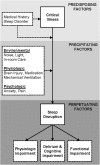Creating Naptime: An Overnight, Nonpharmacologic Intensive Care Unit Sleep Promotion Protocol
- PMID: 30214923
- PMCID: PMC6134539
- DOI: 10.1177/2374373517747242
Creating Naptime: An Overnight, Nonpharmacologic Intensive Care Unit Sleep Promotion Protocol
Abstract
Introduction: Patients in the intensive care unit (ICU) have significantly disrupted sleep. Sleep disruption is believed to contribute to ICU delirium, and ICU delirium is associated with increased mortality. Experts recommend sleep promotion as a means of preventing or shortening the duration of delirium. ICU Sleep promotion protocols are highly complex and difficult to implement. Our objective is to describe the development, pilot implementation, and revision of a medical ICU sleep promotion protocol.
Methods: Naptime is a clustered-care intervention that provides a rest period between 00:00 and 04:00. We used literature review, medical chart review, and stakeholder interviews to identify sources of overnight patient disturbance. With stakeholder input, we developed an initial protocol that we piloted on a small scale. Then, using protocol monitoring and stakeholder feedback, we revised Naptime and adapted it for unitwide implementation.
Results: We identified sound, patient care, and patient anxiety as important sources of overnight disturbance. The pilot protocol altered the timing of routine care with a focus on medications and laboratory draws. During the pilot, there were frequent protocol violations for laboratory draws and for urgent care. Stakeholder feedback supported revision of the protocol with a focus on providing 60- to 120-minute rest periods interrupted by brief clusters of care between 00:00 and 04:00.
Discussion: Four-hour blocks of rest may not be possible for all medical ICU patients, but interruptions can be minimized to a significant degree. Involvement of all stakeholders and frequent protocol reevaluation are needed for successful adoption of an overnight rest period.
Keywords: circadian rhythm; clustered care; delirium; intensive care unit; sleep.
Conflict of interest statement
Declaration of Conflicting Interests: The author(s) declared no potential conflicts of interest with respect to the research, authorship, and/or publication of this article.
Figures


Similar articles
-
Pilot study: an intensive care unit sleep promotion protocol.BMJ Open Respir Res. 2019 Jun 7;6(1):e000411. doi: 10.1136/bmjresp-2019-000411. eCollection 2019. BMJ Open Respir Res. 2019. PMID: 31258916 Free PMC article. Clinical Trial.
-
Effect of nocturnal sound reduction on the incidence of delirium in intensive care unit patients: An interrupted time series analysis.Intensive Crit Care Nurs. 2017 Aug;41:18-25. doi: 10.1016/j.iccn.2017.01.008. Epub 2017 Mar 25. Intensive Crit Care Nurs. 2017. PMID: 28351551
-
Abnormal Sleep, Circadian Rhythm Disruption, and Delirium in the ICU: Are They Related?Front Neurol. 2020 Sep 18;11:549908. doi: 10.3389/fneur.2020.549908. eCollection 2020. Front Neurol. 2020. PMID: 33071941 Free PMC article. Review.
-
Sleep Loss and Circadian Rhythm Disruption in the Intensive Care Unit.Clin Chest Med. 2015 Sep;36(3):419-29. doi: 10.1016/j.ccm.2015.05.008. Epub 2015 Jun 29. Clin Chest Med. 2015. PMID: 26304279 Review.
-
Comparison of propofol and dexmedetomidine infused overnight to treat hyperactive and mixed ICU delirium: a protocol for the Basel ProDex clinical trial.BMJ Open. 2017 Jul 13;7(7):e015783. doi: 10.1136/bmjopen-2016-015783. BMJ Open. 2017. PMID: 28710219 Free PMC article. Clinical Trial.
Cited by
-
The effect of nursing care provided to coronary intensive care patients according to their circadian rhythms on sleep quality, pain, anxiety, and delirium: a randomised controlled trial.BMC Nurs. 2025 Feb 7;24(1):143. doi: 10.1186/s12912-025-02793-8. BMC Nurs. 2025. PMID: 39920733 Free PMC article.
-
Nighttime Sleep Duration Is Associated With Length of Stay Outcomes Among Older Adult Survivors of Critical Illness.Dimens Crit Care Nurs. 2020 May/Jun;39(3):145-154. doi: 10.1097/DCC.0000000000000411. Dimens Crit Care Nurs. 2020. PMID: 32251163 Free PMC article.
-
Non-circadian signals in the intensive care unit: Point prevalence morning, noon and night.Heart Lung. 2018 Nov;47(6):610-615. doi: 10.1016/j.hrtlng.2018.07.011. Epub 2018 Aug 22. Heart Lung. 2018. PMID: 30143362 Free PMC article.
-
Pilot study: an intensive care unit sleep promotion protocol.BMJ Open Respir Res. 2019 Jun 7;6(1):e000411. doi: 10.1136/bmjresp-2019-000411. eCollection 2019. BMJ Open Respir Res. 2019. PMID: 31258916 Free PMC article. Clinical Trial.
-
Sleep promotion for hospitalised children: Developing an evidence-based guideline for nurses.Curationis. 2021 Oct 6;44(1):e1-e10. doi: 10.4102/curationis.v44i1.2219. Curationis. 2021. PMID: 34636624 Free PMC article.
References
-
- Barr J, Fraser GL, Puntillo K, Ely EW, Gélinas C, Dasta JF, et al. Clinical practice guidelines for the management of pain, agitation, and delirium in adult patients in the intensive care unit. Crit Care Med. 2013;41:263–306. - PubMed
-
- Knauert MP, Haspel JA, Pisani MA. Sleep loss and circadian rhythm disruption in the intensive care unit. Clin Chest Med. 2015;36:419–29. - PubMed
-
- Cooper AB, Thornley KS, Young GB, Slutsky AS, Stewart TE, Hanly PJ. Sleep in critically ill patients requiring mechanical ventilation. Chest. 2000;117:809–18. - PubMed
Grants and funding
LinkOut - more resources
Full Text Sources
Other Literature Sources

